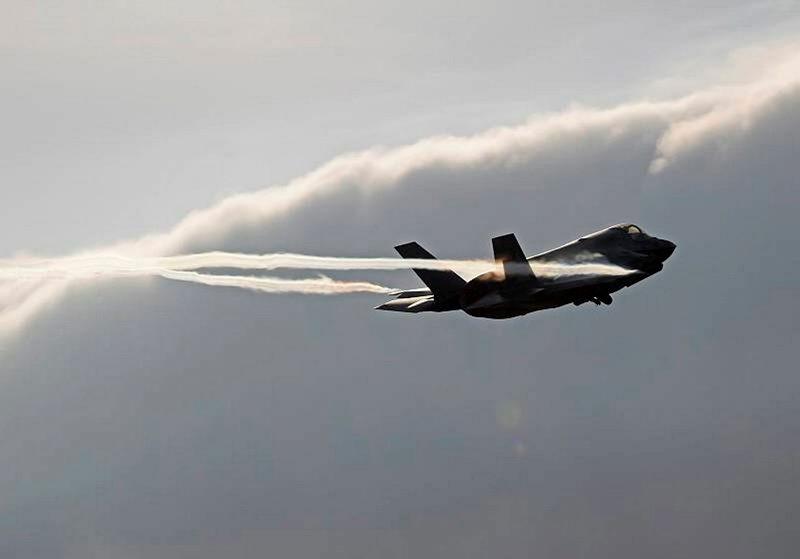
Today, ASPI released our report ‘Jump jets for the ADF?’ (watch the video interview with Ben Schreer here). It asks if there’s a good case for Australia to acquire F-35B Joint Strike Fighter (JSF) short take-off, vertical landing (STOVL) aircraft to operate from the two new Canberra-class landing helicopter docks (LHDs). The Abbott government has directed that this question be addressed in the development of the 2015 Defence White Paper (DWP). Reintroducing organic naval air power into the ADF would be a big strategic decision, not to mention a complex and expensive one. It’s therefore important to consider the circumstances in which such a capability would be worth pursuing. And it’s important to be aware not only of the direct costs but also of the potential risks and opportunity costs.
Because of the potential to launch STOVL jets from the Canberra-class LHD’s ‘ski-jump’ deck configuration, it’s tempting to see the LHD as a potential ‘mini aircraft carrier’. And with 27,000 tonnes displacement and 230 metres of deck, the LHDs are impressive warships. Carrier-based aviation could provide future Australian governments with greater military flexibility in regional and global contingencies. As well, modifying the ships for STOVL operations would open new opportunities for the ADF to train and (potentially) operate with the US Marine Corps.
But on balance we conclude that the benefits from acquiring that capability would be marginal at best, wouldn’t be commensurate with the costs and other consequences for the ADF, and would potentially divert funding and attention from more valuable force-structure enhancements.
Despite their capacity to accommodate a number of STOVL aircraft, the LHDs are multi-purpose amphibious assault ships—not dedicated aircraft carriers. Because of their finite capacity, they can’t carry a full complement of helicopters, and amphibious troops with their vehicles and equipment, and simultaneously deploy a useful number of STOVL aircraft and additional support aircraft. Even in a ‘STOVL-only’ configuration, the LHD would face challenges in generating enough F-35B sorties continuously to protect itself and ships in company against a capable adversary. On the other hand, if the threat levels faced by an embarking amphibious force were low, it’s doubtful a handful of F-35Bs would really be needed.
There’d also be significant direct and indirect costs. It wouldn’t be just about spending money to adapt the LHDs for STOVL operations. If the government was indeed serious about using the LHD/STOVL as a full-time power-projection capability, the ADF would realistically require additional ships to support and protect it. It’s also worth keeping in mind that while the F-35B will be much more capable than the ‘Harrier’ STOVL aircraft, it’s technologically more challenging, more expensive and less capable in terms of combat range and weapons payload than other JSF variants. Even a ‘best case’, conservative cost estimate means the government would need to spend at least $12 billion (acquisition plus through-life costs) on two F-35B squadrons.
That’s a lot of money, both in absolute terms and opportunities foregone to acquire other defence capabilities. For instance, would the F-35B acquisition come at the expense of the RAAF’s F-35A fleet? What about the impact on other critical capabilities such as more-capable future frigates, enhanced special forces, ballistic missile defence, or V-22 Osprey helicopters?
Finally, what are the circumstances in which such a capability might be used? And could other capabilities achieve a similar or sufficient effect? Overall, we struggle to see where the LHD/STOVL option would really justify the costs. When it comes to ADF tasks in the defence of Australia, the additional benefit from STOVL fighters seems to be marginal at best. In the lower-level threat environment of the South Pacific, the capability would be an ‘overkill’. Operations contributing to the defence of Southeast Asia would depend on the nature of the contingency and whether the use of land-based airpower would be sufficient. Further, beyond the reach of Australian land-based aircraft, the challenge of defending the LHD against a capable adversary would be acute.
Last, it’s difficult to see how the LHD/STOVL option could make an important contribution to US coalition operations. There are many other, more effective ways for the ADF to contribute to future US campaigns in Asia and beyond. While the LHDs could be modified to allow STOVL operations by US Marines during joint operations, this option still runs the risk of being tokenism.
That’s why we think the cost-benefit analysis doesn’t support an LHD/STOVL option. The potential costs and risks are significant. The scenarios in which the capability would be realistically required and could make an important operational impact are vague. Therefore, the 2015 Defence White Paper shouldn’t announce a decision or intention to acquire ‘jump jets’ for the ADF. However, if carrier-based aviation is indeed deemed necessary to support a more muscular Australian military posture in the future, the government should consider acquiring a dedicated aircraft carrier, although an earlier ASPI publication has shown that the costs would be significant.
Richard Brabin-Smith is a Visiting Fellow at the Strategic and Defence Studies Centre of the Australian National University. Ben Schreer is Senior Analyst for Defence Strategy at ASPI. Image courtesy of UK Ministry of Defence.